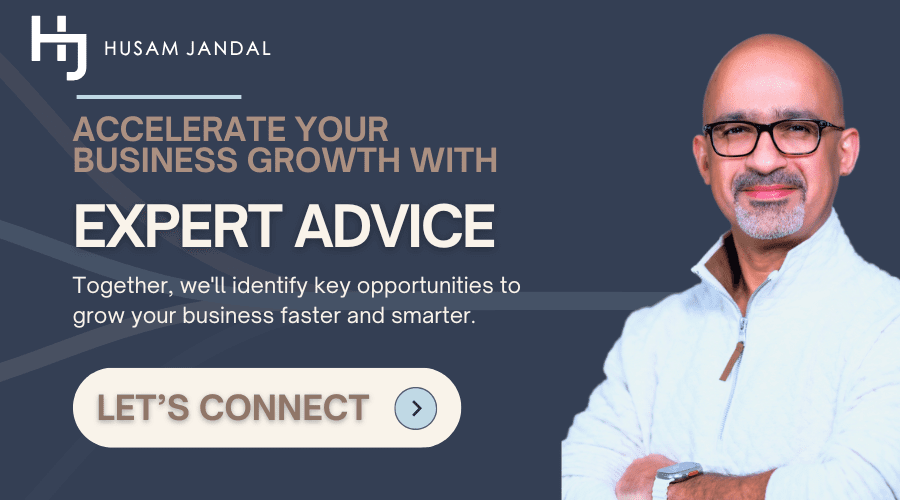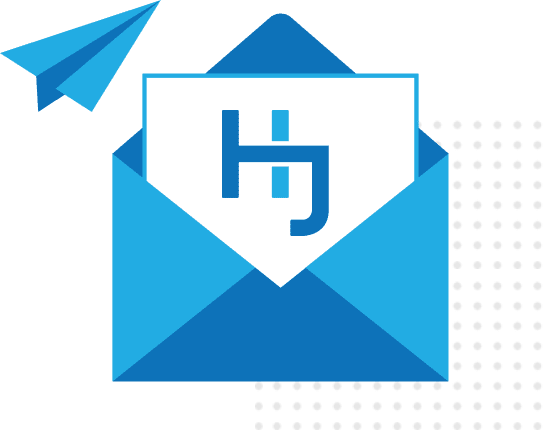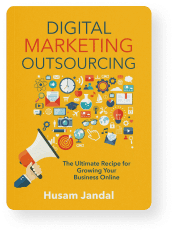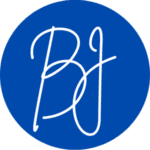 If you’ve poured resources into bottom-of-the-funnel (BOFU) content but still struggle to close leads, you’re not alone. Many businesses rely on funnel position to guide their strategy. However, the funnel stage doesn’t tell you what a buyer actually wants, or when. Intent-based marketing closes that gap and allows you to meet your customers where they are, so you build stronger relationships and convert more often.
If you’ve poured resources into bottom-of-the-funnel (BOFU) content but still struggle to close leads, you’re not alone. Many businesses rely on funnel position to guide their strategy. However, the funnel stage doesn’t tell you what a buyer actually wants, or when. Intent-based marketing closes that gap and allows you to meet your customers where they are, so you build stronger relationships and convert more often.
In this guide, I’ll walk you through the mechanisms behind this and outline the basic frameworks for making intent-based marketing work for you.
The Sales Funnel Still Matters, But it’s Not Enough Alone
Most marketing strategies still lean on a familiar structure: the sales funnel. It’s a simple, intuitive model: awareness at the top, consideration in the middle, and decision-making at the bottom. This framework allows teams to organize content, allocate budgets, and tailor messaging to where a lead is “supposed to be” in their journey.
The Sales Funnel Keeps Things Simple
- Top of Funnel (TOFU): These prospects are in the early stages. They’re becoming aware of a challenge or opportunity, and they’re just starting to gather information. Blog posts, social media content, and introductory guides often live here.
- Middle of Funnel (MOFU): Buyers at this stage understand their problem and are exploring different types of solutions. They’re comparing approaches, reading case studies, or joining webinars to evaluate fit.
- Bottom of Funnel (BOFU): These prospects are evaluating specific providers, looking at pricing, reading reviews, and asking direct questions. They are closest to making a decision.
Businesses Still Lean on the Sales Funnel Model
In many ways, the marketing funnel still holds value. It helps teams avoid dumping all their efforts into one stage. It encourages progression, ensuring there’s something for prospects at each level of engagement.
Relying Solely on the Sales Funnel Model Leaves Gaps
Despite its usefulness, the traditional funnel has critical blind spots. It assumes that buyers move predictably from one stage to the next. It treats lead stages as static and assumes timing and intent based on form fills or page visits.
Yet, we’ve known for years that people have multiple touchpoints before taking action, with some engaging in more than 500 digital touchpoints before reaching a decision, according to Google. Nowadays, consumers interact with more than 130 mobile touchpoints in a single day, the search engine reports. These new interconnected journeys look more like webs than they do linear processes. Buyers often skip steps, loop back, or engage deeply before ever becoming a lead.
Consider the process of shopping for a new computer. You might begin with a broad search like “best computers for work,” gathering general information. As your research deepens, you identify specific needs, such as RAM, operating system, and screen size, and begin comparing models that meet your criteria. At this point, you appear to be close to making a decision.
But then, you come across a product description that highlights graphics cards, prompting you to reconsider your requirements. You return to researching specifications you had not initially prioritized. Later, you see a TikTok video that suggests that a laptop might better suit your needs than a desktop, and portability becomes a new deciding factor. What began as a linear path has now looped and shifted in response to new information.
This is how today’s buyers move through the decision-making process. Their journeys rarely follow a straight line. Instead, they zigzag across a web of channels and touchpoints, often revisiting earlier stages as new insights emerge. For marketers, recognizing this behavior is essential. It’s no longer about guiding prospects down a funnel but meeting them wherever they are within their own evolving path.
BOFU Alone Doesn’t Close Deals
BOFU often gets the lion’s share of attention. It’s the stage where buyers are presumed to be making final decisions, such as comparing providers, reviewing pricing, and narrowing their shortlist. That makes it a natural place to focus budget, time, and sales energy. But, treating BOFU as a shortcut to conversion often leads to missed opportunities.
BOFU Activity Doesn’t Always Reflect Readiness
Just because someone interacts with BOFU-stage content doesn’t mean they’re ready to move forward. In many cases, they’re still exploring. A prospect might be:
- Benchmarking: Comparing pricing or features to make a business case, not to make a purchase.
- Gathering Ideas: Looking for solutions to refine their needs, not to choose a vendor.
- Delegating Research: Surfacing in your funnel on behalf of someone else who will make the final decision.
- Planning Ahead: Browsing today to support a project that won’t launch for months.
These behaviors may look like buying signals, but don’t necessarily indicate urgency or intent.
Standard BOFU Tactics Often Miss the Mark
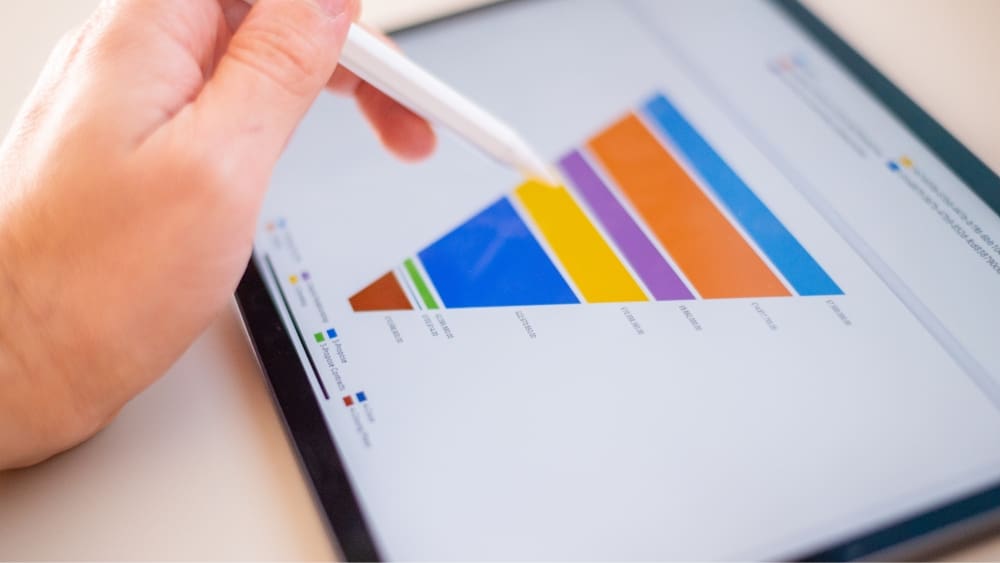
When teams rely too heavily on the funnel stage without assessing behavior, common BOFU tactics can easily be:
- Too Soon: Following up after a quick glance at pricing may feel rushed or pushy.
- Too Generic: Sending the same message to every BOFU visitor overlooks context and reduces relevance.
- Too Late: Failing to respond to strong behavioral signals, such as repeated visits to high-value content, can result in lost momentum.
Without intent signals, even well-executed BOFU campaigns can underperform.
Volume at the Bottom Doesn’t Guarantee Conversions
Many teams celebrate large numbers of “decision-stage” leads, but those lists rarely convert as expected. That’s because:
- Lead Scoring Can Be Misleading: Activity volume or page visits don’t always equate to interest.
- Segmentation May Be Too Broad: Without behavioral nuance, messaging lacks precision.
- Assumptions Replace Insights: Relying on funnel logic leads to one-size-fits-all outreach.
Intent Brings Clarity to the Bottom of the Funnel
To unlock better results at BOFU, marketers need a deeper layer of insight. Intent signals provide context that the funnel alone cannot:
- Why the Prospect is Engaging: Surface-level actions are tied to a specific goal or need.
- How Ready They Are to Buy: Behavior reveals timing better than static labels.
- What Type of Outreach Fits: Messaging aligns to the buyer’s actual mindset, not just their stage.
Without intent, BOFU efforts rely on assumptions. With it, teams can engage with confidence, clarity, and results.
Intent-Based Marketing Improves BOFU Precision
Intent-based marketing doesn’t replace the funnel. It enhances it by helping you see what the funnel alone cannot. It clarifies why buyers are taking action, what they’re hoping to accomplish, and how close they are to making a decision. That makes it especially powerful when applied to bottom-of-funnel strategies.
Rather than relying on static stages or assumptions, intent-based marketing uses real-time behavioral signals to guide your approach.
Intent Data Tells You More Than Funnel Stage
With intent-based marketing, you’re not guessing based on content type or form fills. You’re interpreting specific patterns of behavior that signal buyer interest and readiness. For example:
- Repeated Engagement: Someone who visits your pricing, testimonials, and product tour pages over several days likely has higher intent than someone who views them once.
- Topic-Level Interest: A prospect who consistently consumes content on a single topic is signaling a clear priority.
- Cross-Channel Activity: A user who clicks your ad, downloads a resource, and then revisits your site via organic search shows growing urgency.
These actions provide a far clearer picture of buyer motivation than funnel position alone.
Intent Bridges Gaps Between Stages

Real-world buyer journeys rarely follow the funnel cleanly. Intent-based strategies help you meet buyers mid-zigzag by:
- Identifying Regression: Spotting when someone returns to early-stage content after a BOFU action, signaling the need for education, not pressure.
- Surfacing Acceleration: Detecting when someone moves quickly through multiple touchpoints, showing readiness to engage sooner than expected.
- Uncovering Hidden Stakeholders: Recognizing new visitors from the same account who are validating or researching on behalf of a team.
Instead of tracking progress by funnel stage, intent allows you to track it by behavior and act accordingly.
With Intent, Timing, and Messaging Improve
When you act on buyer signals instead of assumptions, outreach becomes more relevant and better received:
- More Timely: You connect when interest is high, not days after it fades.
- More Personalized: You tailor messaging based on the topics or pages that triggered engagement.
- More Strategic: You allocate resources to accounts or leads showing real traction, rather than chasing every form fill.
Applying Intent to BOFU Requires Strategy
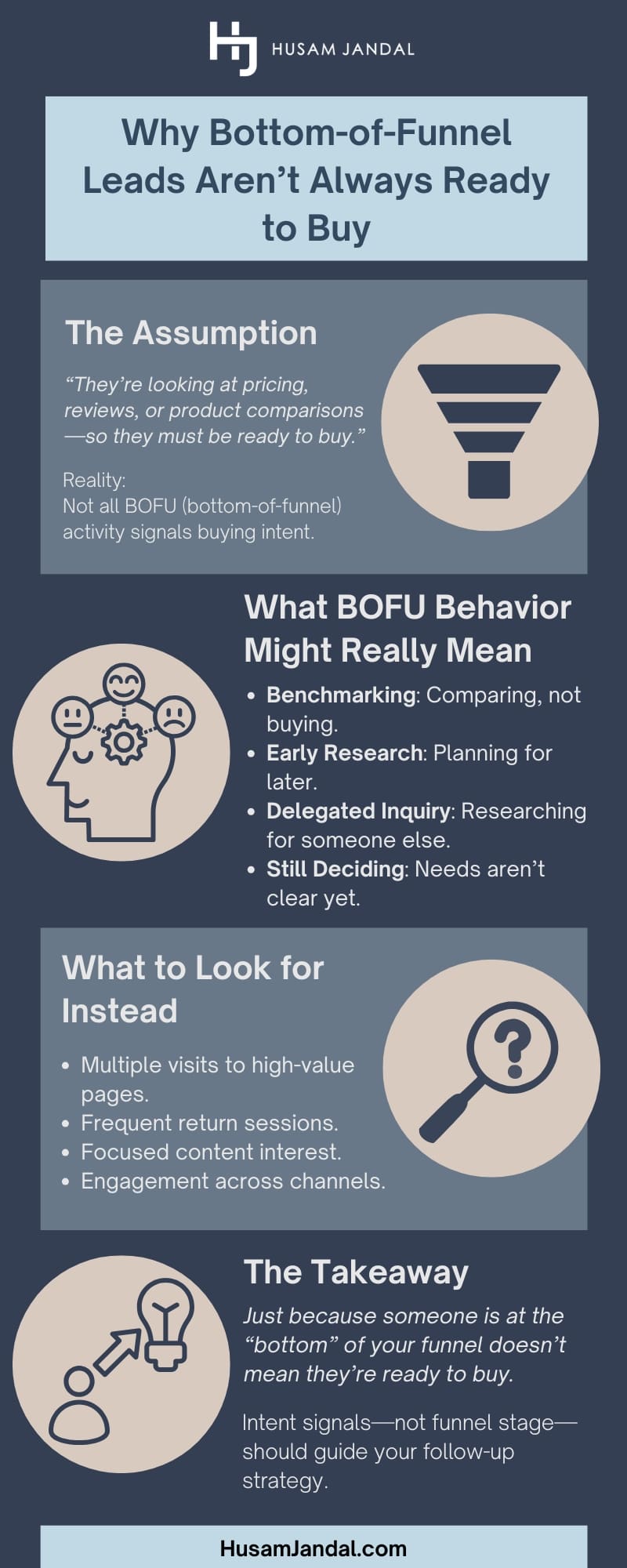
Recognizing intent is only the first step. To make it actionable, you need a strategy that translates behavioral signals into tailored outreach, timely offers, and relevant content. This is where many teams fall short; not because they lack data, but because they treat every BOFU lead the same.
Intent-based BOFU strategies allow you to adapt your approach based on how buyers are behaving, not just what stage they’re in.
Use Behavior to Guide Messaging
Instead of relying on default CTAs or static email sequences, align your messaging with observed actions:
- Refine Based on Interest Type: If someone spends most of their time on ROI-related content, lead with value proof, not product specs.
- Adapt to Level of Engagement: A prospect with repeated deep engagement may be ready for a call, while a first-time visitor might respond better to a short guide or case study.
- Mirror the Buyer’s Language: Use page paths and search terms to understand their vocabulary and echo it in outreach.
When messaging reflects what the buyer actually cares about, it feels less like marketing and more like relevance.
Let Intent Influence Timing and Cadence
One of the most powerful benefits of intent is the ability to reach out at the right moment, before interest cools but after it’s been meaningfully established.
- Prioritize Hot Signals: Follow up quickly with those showing sustained or repeated BOFU-level activity.
- Pause When Interest Drops: Back off when engagement stalls, and let automation watch for reactivation.
- Match Cadence to Urgency: Fast-moving buyers may need same-day outreach. Others may need space and a slower drip.
Timing based on behavior, not the calendar, leads to more natural conversations and stronger conversion rates.
Segment Beyond Stage
Traditional segmentation often groups leads by lifecycle stage. Intent-based segmentation looks at behavioral quality and momentum:
- High-Intent, High-Fit: Prioritize for personal outreach or tailored offers.
- High-Intent, Low-Fit: Consider nurturing or routing to more appropriate products or services.
- Low-Intent, High-Fit: Use light-touch, value-building campaigns to build trust.
- Low-Intent, Low-Fit: Avoid overinvestment and let them qualify themselves over time.
Intent lets you spend your time where it matters most and avoid wasted effort on leads who aren’t ready or aren’t a match.
Put Intent-Based Marketing to Work for You
Intent-based marketing is powerful, but applying it effectively requires more than theory. It takes strategy, tools, and a coordinated team to turn behavioral data into measurable results.
That’s a tall order for small and mid-sized businesses, especially when marketing is just one of many competing priorities. I’ve worked with owners who try to do it all, only to get stuck when it’s time to scale or optimize.
I’m here to get you unstuck. As a digital marketing consultant with a background in business and decades of experience, I can build the right strategy, assemble the right team, and turn intent signals into real results. If you’re ready to explore what that might look like for your business, let’s talk.
FAQs on Intent-Based Marketing
How does intent-based marketing work at the bottom of the funnel?
It helps you identify which buyers are truly ready to act, so you can tailor outreach, offers, and timing based on behavior, not assumptions about funnel stage.
Is BOFU the same as high intent?
No. BOFU (bottom of funnel) describes where someone is in your content journey. Intent reflects how ready they are to buy. The two don’t always align.
What are examples of buyer intent signals?
Examples include repeated visits to pricing pages, in-depth engagement with solution content, and return visits through search or email, especially in a short timeframe.
Why isn’t my BOFU strategy converting?
Many BOFU campaigns rely on assumptions instead of buyer signals. If your messaging is mistimed or too generic, it won’t connect, even with decision-stage leads.
What are common BOFU marketing mistakes?
Pushing too soon, using one-size-fits-all messaging, and failing to respond to strong engagement are common BOFU mistakes that reduce conversion potential.
What’s the difference between lead scoring and intent signals?
Lead scoring is often based on arbitrary actions. Intent signals reflect real buyer behavior, helping you focus on quality engagement, not just activity volume.
How can I tell if a lead is ready to buy?
Look for signs like multiple return visits, comparisons of your offerings, or content engagement that’s focused, repeated, and signals solution-specific interest.
Can small businesses use intent-based marketing effectively?
Yes, especially when paired with the right strategy and support. Even simple tools and lean teams can use intent signals to improve conversions.
What is bottom-of-the-funnel marketing?
Bottom-of-the-funnel marketing focuses on prospects who are close to making a purchase decision. It includes strategies like product comparisons, pricing pages, and sales outreach, but without intent data, it’s easy to misjudge buyer readiness.
How do I identify high-intent leads?
High-intent leads typically show focused, repeated engagement with solution-specific content, pricing pages, or decision-making resources. Their actions suggest they’re actively evaluating options and ready to take the next step.
What is conversion-driven marketing?
Conversion-driven marketing prioritizes actions that move buyers toward a purchase. It relies on behavioral data and targeted messaging to reduce friction and guide the prospect from interest to decision.
How should I approach marketing to ready-to-buy customers?
Marketing to ready-to-buy customers requires timely, personalized outreach. Use behavioral signals to trigger relevant offers or conversations that match where the buyer is in their decision process.

